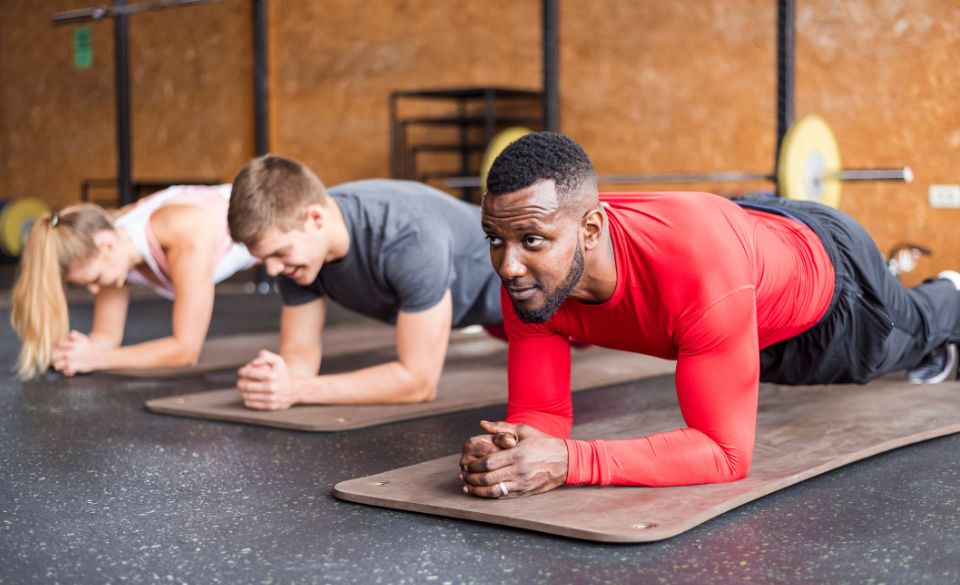
Top 5 Isometric Exercises For Runners
Page Contents
What Are Isometric Exercises
Isometric exercises are a type of strength training that involve the contraction of a specific muscle or group of muscles without any visible movement in the angle of the joint. While the muscle is under tension, the joint angle and muscle length do not change, resulting in no movement. During these exercises, the muscle does not shorten and lengthen like it does during dynamic exercises such as bicep curls or squats.
Isometric exercises have been around for centuries and have been used by martial artists, meditators, yogis, and athletes, to name a few. They were popularized in the early 1960s and are becoming increasingly popular in the fitness world today.
Isometric exercises can be beneficial to any fitness level or age group. They can help build strength, increase muscular endurance, and even improve joint stability. Additionally, they can be great for rehabilitation purposes and for addressing muscle imbalances. Since isometric exercises do not require specialized equipment, they can also be preformed anywhere, making them great for those on the go.
When it comes to performing isometric exercises, there are few general rules to follow. First, you should hold the contraction for 10-60 seconds. During the contraction, maintain proper body alignment and be sure to breathe normally. Lastly, whenever possible, use a partner or wall to provide added resistance.
Isometric exercises are an effective way to build strength, improve joint stability, and address muscle imbalances. They can be preformed anywhere and require no specialized equipment. However, be sure to follow the general guidelines noted above to ensure you are getting the most out of your workout.
Why Are Isometric Exercises For Runners Important
Isometric exercises are an important part of any runner’s training program, but many runners often overlook them when planning their training. Isometric exercises are static exercises that involve an athlete remaining still while holding a position to increase muscle strength and endurance. Runners often focus on aerobic exercises and long runs, but strength and mobility work is a key component of any runner’s routine.
Strengthening the muscles that support the knee, hip and ankle joints can help runners stay injury free and prevent common running ailments such as runner’s knee and shin splints. Isometric exercises are particularly beneficial for runners because they help to improve muscle strength and stability without adding any extra impact to the joints and muscles. Isometric exercises can also help improve flexibility, which is important for running efficiency and reducing the risk of injury.
Additionally, isometric exercises can help runners build the core strength needed for better posture, improved balance and stronger strides. Core strength is essential for running as the core muscles are integral to power, speed and endurance. Isometric exercises can also help runners increase muscle endurance and reduce overall fatigue.
Finally, isometric exercises provide a convenient way for runners to add strength training to their training program without taking too much time. Isometric exercises are quick and easy to set up and require minimal equipment. Any runner can benefit from the benefits of isometric exercises, and they are perfect for those who are strapped for time or don’t have access to a gym.
Isometric exercises can help any runner improve their performance, stay injury-free, and see results faster. So, if you’re looking to take your running to the next level, be sure to add isometric exercises to your routine.
Top 5 Isometric Exercises For Runners
Isometric exercises are a great way for runners to improve their running performance and prevent injury. Isometric exercises involve using your muscles to exert force against an immovable object, such as the floor, a wall, or a chair. These exercises don’t involve actually moving your joints, but still provide an intense workout that can help strengthen your muscles and increase endurance.
Here are the top five isometric exercises that runners should incorporate into their routine:
1. Wall Sits: This exercise is great for strengthening the lower body and improving balance. To do this exercise, stand with your back against a wall, making sure your feet are shoulder-width apart. Bend your knees and slowly slide your back down the wall until your thighs are parallel to the floor. Hold this position for as long as you can, then return to standing.
2. Plank: This core exercise is essential for runners, as it strengthens the abdominal muscles and helps to improve posture. To do this exercise, get into a push-up position, but rest your weight on your elbows and forearms instead of your hands. Keep your body in a straight line and hold this position for as long as you can.
3. Glute Bridge: This exercise strengthens the glutes, which are often neglected by runners. To do this exercise, lie on your back with your knees bent and your feet flat on the floor. Lift your hips off the floor, squeezing your glutes as you do so. Hold the position for a few seconds and then lower your hips back down.
4. Standing Calf Raises: This exercise will help to strengthen the calves, which are important for runners as they help to improve speed and endurance. To do this exercise, stand with your feet hip-width apart. Slowly raise your heels off the ground, pushing through your toes as you do so. Hold the position for a few seconds and then lower your heels back down.
5. Side Plank: This exercise is great for strengthening the obliques, which are important for runners as they help to reduce movement in the lower back and improve posture. To do this exercise, lie on your side and raise yourself up onto your elbow. Keep your body in a straight line from your head to your feet and hold this position for as long as you can.
These are just a few of the many isometric exercises that runners can incorporate into their routine. Doing these exercises regularly can help to improve running performance and reduce the risk of injury.


